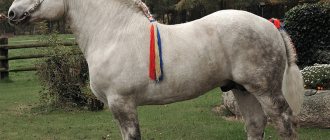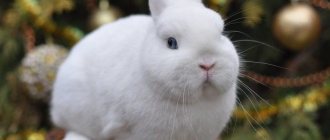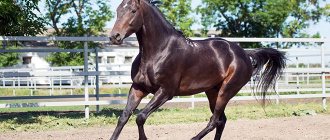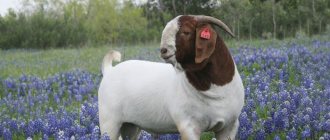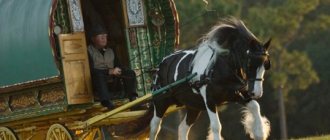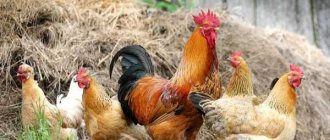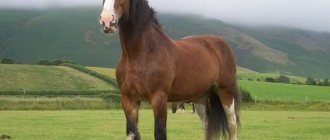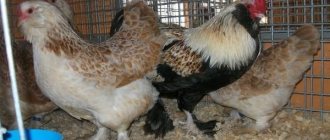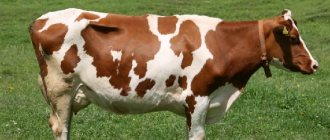The Don horse among domestic purebred breeds is considered one of the oldest and at the same time the most original. It was bred as a universal breed, suitable for both riding and harnessing. Donchak have never been the best horses and have always been inferior to pure riding breeds, but their endurance is truly legendary. Unfortunately, today this breed is on the verge of extinction, and it is possible that it will disappear before the end of the century. Already now, Don horses in videos are very rare, being much inferior in popularity to Arabian, English and Akhal-Teke horses.
Use of Don horses
Perhaps this is the most versatile breed; it is used in almost all areas where possible.
Horses are perfect for sports (jumping, dressage, racing, cross-country), and for agriculture, and for harness driving. They are famous as the most durable horses. They can run incredible distances without rest, as proven by a 1951 experiment. It consisted of driving the Donets over a distance of 120 km over the course of 2 weeks. As it turned out, the Don horse does not get tired from such a load, remains in good shape and manages to fully restore its strength in a matter of hours of sleep. But now the Donets are most popular as horses for beginners! All this is due to its peaceful, pliable nature.
The Don breed is an excellent choice for beginners as well as for experienced riders. And if you have already become the owner of this horse, then my congratulations to you! You probably know how lucky you are!
Scope of application
Don breed horses are used in equestrian sports: show jumping, dressage and eventing. In particular, as amateur participants. But sometimes they show excellent results at serious competitions and Championships.
Suitable for children and experienced athletes. For walks in the fields and rentals. Often used in hobby classes and for teaching beginners. But not all horses. Only the calmest ones. After all, many show character.
In addition to sports, they are used for running. Less often - in horse racing. They often take prizes in international long-distance and jogging tournaments.
These horses are completely unsuitable for harnessing the plow and agricultural work.
Often representatives of the Don breed of horses serve in the mounted police. And they give people sled rides in winter. And of course, they are found in equestrian schools.
Breed Features
The Don Horse is a representative of the group of harness horses, which was bred on the territory of the modern Rostov region. Her birth occurred due to the mixing of blood of wild steppe herds, Turkmen, Karabakh, Akhal-Teke and Persian horses. Long-term selection work allowed these animals to increase their height quite significantly, losing the usual appearance features of their wild and eastern ancestors.
You will learn a lot from the video “All about the Donetsk people”.
These horses were very popular among the Don Cossacks, who put a lot of effort into breeding the Don people and their further development. Thanks to the Cossacks, the Donchak received its endurance, lightness and courage, for which this breed is famous. In addition, the famous red coat, a distinctive feature of all Don horses, appeared thanks to the Cossacks. Using horses in battles, the Cossacks tried to achieve one color of the animals so that they would look like a large mass capable of intimidating the enemy.
Origin story
As we said earlier, in the open spaces near the Don River, people have since ancient times used the steppe horses living there. But only with the arrival of the Cossacks there was a sharp increase in interest in the development of local horse breeding. The great need for high-quality horses capable of carrying heavy loads while maintaining speed and unpretentiousness led to the fact that the first stud farms began to appear in the Don expanses. The basis of the new breed bred there was the various horses that the Cossacks inherited after several Turkish companies.
The Don owes its beauty and grace to the eastern horses, whose blood was gradually mixed with them. Thus, Arabian, Akhal-Teke and Persian horses were used. For the first time, these animals were appreciated only in 1910 at the All-Russian exhibition. The Donchak, being a model of an army horse, has gained considerable popularity in many sports, but now they are mainly used to improve local breeds, since with the collapse of the Soviet Union, the breeding of Don horses went into decline.
Exterior
The Don breed of horses has a red color, which can range from light to dark. The legs of these animals are quite long, matching the same body and straight back. There are 4 varieties of this breed, let's talk about them separately.
- Persian, formed from the blood of Persian and Turkish horses. They are distinguished by their tall height (160-165 cm) and refined head features, wide neck, and chest. They have soft golden fur and mane.
- The East Karabakh horse is somewhat shorter than its relatives (up to 160 cm). The body and head are more rounded. These horses are dominated by dun color in color.
- The eastern massive variety is distinguished by very high growth and body weight (165-170 cm at the withers). But thanks to the elongated lines, the animal’s body does not seem massive. These horses are usually red.
- Saddlebred is a light, tall horse that is most often used for military or sporting activities. They are distinguished by the absence of a golden shimmer, which is found in the fur, tail and mane of other varieties.
Character
The Don breed of horses has a rather complex character. The fact is that their origin and admixtures of eastern blood make these animals quite active, even “groovy.” It will not be very easy for a beginner in horse riding to cope with an angry Donchak. From time to time they can “play” with their rider, marking bouts of good mood with “goats” and “candles”. This is also worth considering when choosing a rider for such a horse.
However, it has been noted that the majority of Don horses have a rare selectivity and loyalty to one rider they love. An animal can happily help a chosen person, but show malice towards all others. At the same time, most animals are easy to train if you start training the foal in time. In addition, representatives of the Don breed are quite disciplined animals.
Exterior
The Don breed consists entirely of horses of various shades of red color. For the most part, they are stocky: not too tall, but have a wide chest and forehead, so they look quite harmonious. The Donets themselves are elegant, have a smoothly curving neck line and stable legs.
In the Don breed, their eastern origin is most noticeable, which is expressed in short stature, expressive eyes, deep girth and relative dryness. The second element was the sharpening of the breed for cavalry, which is expressed in the elongation of the body, the high crest of the mane and the main physical characteristics (endurance and unpretentiousness).
The following types of bottom rock are distinguished:
- The riding type is the latest “model”, which is distinguished by a long neck and above average height. Such horses were bred by mixing English breeds. Kohl became taller and, by an order of magnitude, more European, but lost the golden hue of red.
- The Persian type is one of the very first types bred on the basis of oriental breeds. They are tall at the withers (at least 163 centimeters), have a long head and a bright golden hue. The chest is narrower than other types, which can also be said about the head. The nostrils are large and also narrow.
- The East Karabakh type is an excellent representative of the Mongolian family, preserving all the exterior advantages of the steppe horse. They are short, stocky, the mane and tail are often darker than the main color.
- The eastern massive type is the result of long selection work. As a result of working on the development of a heavy draft version of the Don breed, horse breeders received a large horse, wide in all respects, with long body lines that balance its massiveness and make it harmonious. The color of such horses is most often darker than the classic Don color.
Characteristics of Don horses
The early, Old Don breed was smaller in size than the modern one, but was extremely fast and hardy. The main characteristics of the breed were:
- Small and narrow head
- Straight forehead
- Low, pointed, close-set ears
- Neck with no Adam's apple, proportionally folded
- Wide chest
- The back is short
- Sacrum elongated
- Wide bones but dry feet
- The body is muscular and dense
- The coat is short and delicate
- Mane and tail hairs are thin
- Wide hooves
It was extremely important to have the correct proportions of the entire horse, modeled on eastern horses.
The Novo-Donskaya breed has acquired slightly different characteristics:
- Height increased - up to 175 cm
- The head has become broad-browed
- The neck became short and with an Adam's apple
- The back is carp-shaped
- Knees low and concave inward
The color became red, looking very polished. The chest girth has become narrower, and the strength of the joints has increased.
The character of horses depends on how they are kept. Horses living in a herd become more independent; those kept in a stable are more loyal and flexible to humans. As a rule, they recognize only one owner, and treat strangers with distrust and even anger.
History of the appearance and development of the breed
The Don breed of horses has an inextricable connection with the history of the Don Cossacks. The first stud farms appeared on the Don back in the eighteenth century. The very first Donetsk dogs were immediately distinguished by their agility and flexibility, which allowed them to easily overcome natural obstacles, perform the sharpest turns, while showing a high level of endurance.
Since, despite all these qualities, they were still very unpretentious in feed and care, and with the proper level of maintenance they could easily live up to twenty years, it was very difficult to come up with the best combat horses for that time.
Beginning in the nineteenth century, the Don Cossack atamans Platov, Ilovaisky and Martynov began to work closely on improving the Don breed. It was from their herds that a new round of development of these wonderful horses began.
This Don chieftain brought the best representatives of Arabian and Persian horses to his factory, using selection and selection methods in breeding.
Then stud farms began to appear everywhere on the Don. In 1776, the Yanov stud farm opened, two years later - the Ilovaisky (A.V.) and Serikov stud farms, and in 1790 the Kuznetsov and N.V. stud farms appeared. Ilovaisky.
The unpretentiousness and endurance of the Don people is evidenced by the following fact: during the Anglo-Boer War, which lasted from 1898 to 1902, all the horses of the English cavalry fell, and two hundred Don horses, which were in the detachment of General French, continued to bravely carry service and endure all the hardships and hardships of wartime.
To further improve this Russian product, the best representatives of purebred riding and Arabian breeds were actively used.
A group of beautiful golden-red riding horses was put on display for the judgment of picky experts. The judges immediately appreciated these wonderful animals and considered them a national treasure of the country. Since that time, Don horses have received official recognition and popular love. They began to be actively used for breeding work to improve the local livestock, and were also actively recruited for army service.
Under the control of the Soviet Horse Breeding Administration on the Don, retired cavalry officers and Don horse breeders carried out active breeding work, which yielded positive results fifteen years later.
Several facts that testify to the extraordinary endurance of the Donetsk people:
- 1946 The Don Cossacks traveled from Salsk to Rostov-on-Don (distance - 200 kilometers) in 18 hours and 25 minutes. And this is at an ambient temperature of 40 degrees;
- a Don mare named Bukvarka's Daughter ran one thousand seven hundred seventy-seven kilometers in fifteen days, without ever stopping for a day;
- a whole group of Don breed stallions covered a distance of 305 kilometers, spending 20 hours on it;
- the record for the distance traveled in one day belongs to a stallion named Skid - 300 kilometers in nineteen hours;
- 1951 To determine the maximum degree of endurance of these horses, the Marshal Budyonny stud farm organized a race, the essence of which was to run 120 kilometers every day for as long as possible. Two weeks later the race was stopped. The horses felt great and there was no point in continuing the test.
This negative trend is due to the fact that former state-owned breeding farms and farms passed into the hands of private capital, which turned out to have no need for them. The Ministry of Agriculture is also not at all interested in these beautiful animals, and all the breeding work to preserve the Don horses lies on the shoulders of a few enthusiasts.
Bibliography:
- A.P. Soldiers. Basics of animal husbandry. — 3rd ed. - M.: Agropromizdat, 1988.
- Animal husbandry // Great Soviet Encyclopedia: / Ch. ed. A. M. Prokhorov. — 3rd ed. - M.: Soviet Encyclopedia, 1969-1978. (Retrieved April 5, 2012)
- Animal husbandry - Wikipedia
- Animal husbandry // Encyclopedic Dictionary of Brockhaus and Efron: in 86 volumes (82 volumes and 4 additional). - St. Petersburg, 1890-1907.
Victorious moments
Overcoming routes
Don horses have merits in sports, but not many people know about them.
Famous case: a trip from Rostov-on-Don to the city of Salsk in 1920. Several breeds took part: Akhal-Teke, Arabians, thoroughbred horses and others.
The best result was achieved by the Donchak, who covered the route in 19 hours. And this despite the fact that the air temperature during the competition was more than 40 degrees. The horse endured all the inconveniences without complications. And I was ready to move on.
In the same year, an endurance tournament of Don breed horses was held. 200-250 heads took part. The best result was shown by the horse Daughter of Bukvarka. She covered more than 1,700 kilometers in 15 days. The Don stallion Zanos showed a good time. He walked 300 kilometers in 19 hours.
How to maintain and care
The main rule of communication
The Don horse is unpretentious. But because of her character, it is sometimes difficult to deal with her.
For representatives of this breed, there is one cherished rule - not to pay much attention to them. Otherwise, the Donetsk people begin to become impudent. And no longer behave affectionately, but rather the opposite.
Nuances of care
After each training session, the horse's legs are washed under cool water. It is recommended to additionally lubricate them with special cooling and insulating creams.
The hooves are lubricated with a special varnish. And from time to time they are treated with hydrogen peroxide. This way they will not crack and cause pain to the animal.
Once every six months, the Don horse is given new horseshoes. The cost of such a procedure is about 2000 rubles. Hoofs are cleaned once every two months. Price – 500 rubles. It is advisable to have a specialist do this.
Tip: before each workout or work, moisten the cotton wool with water. And thoroughly rinse the animal’s nostrils. After this procedure, the nose is cleaned. And the horse breathes better.
Additional requirements
It is important to encourage a horse or horse of the Don breed. These are quite vulnerable animals.
And at a young age they are also difficult to manage.
Before training, the pet is given a carrot or an apple each time. This way he will begin to understand that good gaits will reward him with goodies. The method is used to strengthen control. And I must say that it works.
The area of the stall for keeping horses of the Don breed should be 12 square meters per individual. Be sure to have a large window without broken glass, and a feeding trough with a drinking bowl. If possible, “balconies” are also installed in the stables - exits to the street.
In winter, you need to put a thick stall blanket on the animal. In bad weather - fleece.
From late October to mid-December, blankets that are less insulated than winter blankets are usually used. If a horse gets used to standing in a stall in a winter blanket at a temperature of 5 to 15 degrees, then in cold weather it will simply freeze.
Content Tips
Don breed horses can be kept not only in stables, but also in herds, where, in the process of free grazing, an individual can gain the muscle mass it needs. The daily feeding volume for an adult horse should be at least 2-3% of its body weight. The more a horse moves, the more feed it needs to consume to regain strength. The horse's food and water should always be fresh.
Donchak do not tolerate wilted grass well. The optimal food for them is oats, vegetables, hay, and salt. Feeding is carried out three times a day, and in between meals the horse must move actively. It should be remembered that activity is possible only 2 hours after eating, since the process of digesting what is eaten in this breed takes exactly this period of time.
In addition to feeding, it is important to care for your horse daily, as its health depends on it. The coat should be brushed, the eyes and nostrils should be wiped with a damp cloth every morning, the mane and tail should be combed, after walks the legs should be washed, and the hooves should be cleaned with a special hook.
Often, to prevent a horse from spraining its ligaments, its legs are bandaged with elastic bandages.
Features of maintenance and care
Don horses are hardy and able to quickly adapt to the environment and climate. Therefore, they do not require “greenhouse conditions”. These strong animals can run 120 km daily without even showing signs of fatigue. But there are still requirements for maintenance and care, and they must be observed in order to avoid problems with the health and behavior of individuals.
Stable
When arranging a stable with a stall, consider the following requirements:
- ceilings at least 3 m, higher is better;
- stall dimensions for Don horses – from 4x4.5 m;
- door passage width – from 1.2 m;
- wall thickness from 4 cm;
- height of solid walls – 1.5 m;
- between the bars of the lattice fence of the walls - a maximum of 5 cm.
The walls of the stall and stables, and any fences, must be designed to withstand the blow of an adult horse and withstand it with ease.
The floor is made of wood or concrete, always on a slope in the stall so that the slurry drains. Special ditches are installed along the stables for this purpose. The floor is covered with straw, sand, sawdust or peat - it must always be dry. The optimal humidity in the stable is 70%, the room temperature is +10...+13 °C. Find out what horse gaits are.
All doors in the stable must open outward. It is important to provide natural artificial lighting in the stable - there should be a lot of windows and lamps. For ventilation, small holes are needed in the walls and doors, but the horse should not be allowed to be in a draft. It is best to choose automatic drinkers - with them the Don horse will not splash water on the floor and there will be a little less work.
Feeding ration
The daily feeding rate for Don breed horses is 1.5–3% of the individual’s weight. The percentage depends on the intensity of use:
- 4 hours a day – light;
- 6 hours – average;
- 8 hours – high.
Increased portions give:
- young animals;
- pregnant women in the last 3 months;
- nursing;
- sick individuals.
An increase in the diet for everyone should occur in winter. Access to water is available 24 hours a day. An adult animal drinks about 60 liters per day. The basis of the horse menu is grass from pastures and hay. This is the main source of fiber, which the pet should receive in a volume of at least 50% of the daily portion. The remaining 50% is:
- roughage (oats, wheat bran);
- vegetables;
- treats;
- concentrates.
The food must be fresh and clean - skimping on the quality of food will make a big hole in your wallet when the animal has to be treated. Don horses should not eat wilted plants - such food causes dangerous colic.
Donchas digest food slowly, so one meal alone can take 2 hours. Feeding is three times a day, the intervals between meals are set depending on the intensity of the horse’s work. The greater the load, the longer the time intervals.
Did you know? Tsar Peter I could not part with his favorite combat assistant, the mare Lisette of the Karabakh breed, ordering a stuffed animal to be made after her death. It is noteworthy that this breed was used in the breeding of Don horses.
Heavy types of Don horses are prone to obesity, so sometimes they should be kept on healthy steamed porridge from:
- 1 kg of oats;
- 7.5 g salt;
- 50 g flaxseeds.
Place all ingredients in a cauldron with boiling water and cover with a lid. Leave until the whole mass is completely soaked, then add 0.5 kg of wheat bran and wrap for 2 hours. Healthy newborn foals eat every half hour to hour for 5–10 minutes. The suckling period lasts up to 6–10 months. under natural conditions, but already during the first month the foal can independently eat some roughage, hay, and grass. Usually the cub is moved to a separate stall from the mother at six months.
in winter
Approximate winter diet of Don horses:
- fiber – 8–14 kg;
- vegetables – 2–6 kg;
- grain – 2.5–5 kg;
- straw – 2–4.5 kg;
- salt – 30–45 g.
The diet is calculated depending on the intensity of use of the individual.
In summer
Summer menu for thoroughbred horses:
- fiber – 2–5 kg (not given if the individual works less than 4 hours a day);
- grain – 2–4 kg;
- straw – 3.5 kg (instead of fiber for those who use it up to 4 hours a day);
- grass – 35–45 kg;
- salt – 25–35 g.
Care and hygiene
The health of Don breed horses depends on proper care and hygiene. The litter is cleaned every day, the room is cleaned once a week. From the inventory personally for the animal's fur you need to purchase:
- hook for hooking;
- brushes with soft and hard bristles;
- hair clipper;
- towels
You need to groom, comb, and clean your pet daily; in the morning, wipe the nostrils and eyes with a damp sponge. Before each horseback ride, the horse is brushed, starting from the muzzle and all over the body. To prevent sprains, wrap your legs with an elastic bandage. Regularly inspect the animal for wounds, comb the mane and tail, and wash the horse’s legs after each walk.
Find out how, how much and in what position horses sleep.
The water should be slightly warm so that the pet does not resist. A hook is used to clean the hooves. Don horses are bathed with special horse shampoos, which can be purchased at a veterinary pharmacy. Cleaning the stall and stables is carried out when the animal is not inside:
- litter is replaced;
- the area is swept and washed;
- Equipment, floors, walls are disinfected (at least once a month).
Do not use chemicals for cleaning, only plain water and gentle cleaning agents. Place clean bedding on the floor only after it is completely dry.
Pregnancy and childbirth
Don mares give birth to one, maximum two foals. A horse's pregnancy lasts 11 months. (320–355 days). In the second half of pregnancy, the need for physical activity decreases and the need for larger portions of food increases. The pregnant mare should be in a spacious stall. The food must be complete and of high quality, giving as much as the animal will eat at a time, until the individual leaves on its own.
Important! There is no need to worry if you see postpartum discharge the day after giving birth - it is normal and may last for 8 days.
The room for childbirth should be light (muted light, dim), dry and clean. There should be no unnecessary noise. A few days before the birth, the floor and walls need to be disinfected. The horse does not need your help; if the pregnancy is progressing normally, it will give birth on its own, most likely at night or early in the morning. The whole process takes about half an hour, the mare breaks the umbilical cord herself. The mother and foal are kept and walked separately from other horses and animals.
Disease Prevention
The best preventive measures against diseases of Don horses:
- quality diet;
- proper care;
- vaccination against viruses;
- compliance with sanitary standards.
Poor quality feed and junk food (young oats, green clover, human food) lead to indigestion and colic, the stomach walls are stretched, which causes pain.
This could be fatal. Similarly with contaminated food - it often causes constipation with bloating. This can lead to bloat and, again, to the death of the animal. Don horses are susceptible to colds, so do not give them too cold water and make sure that they do not stand in a draft. In winter, the temperature in the stable should not fall below +10 °C. For the same reason, do not allow wet bedding in the stall. Unsanitary conditions in the stall and unkempt horse grooming lead to the proliferation of pathogenic bacteria and parasites, causing dermatitis and eczema. If one of the animals gets sick, place it in quarantine until complete recovery, not allowing contact with other animals.
History of the breed
Since ancient times, the south of Russia was inhabited by hordes of steppe inhabitants. One of the main values of this people were horses, which were distinguished by their short stature and amazing endurance. In the 13th-14th centuries, through the joint efforts of the Mongols and Cumans, the herds were united, as a result of which the Nogai breed of horses appeared.
In the 14th century, Cossacks began to settle on the Don, defending the borders of Rus' from the attack of the steppe hordes. For any warrior, his horse played a big role, since human life depended on this animal. To train horses in military affairs and fearlessness, the Cossacks staged raids on hordes. This is how the Don breed of horses appeared.
From the 15th to the 18th centuries, only the Cossacks were interested in improving the breed. The main material for crossing was the Kalmyk breed. At the same time, Arabian, Turkish and Persian breeds were used. The Cossacks wanted their horses to be:
- Brave.
- Hardy.
- Unpretentious.
- Fast.
Much attention was paid to the mental health of the horses and their appearance: they had to be spotless. In the XVIII century
Ataman Platov created the first stud farm on the Don, where they bred and improved the breed.
Particular attention was paid to the uniform, golden color of the horses. The basis for future horses was taken from the special ones from the Trans-Don steppes, from Karabakh and the East
It was the genes of eastern horses that gave the Don horses a beautiful golden color
The basis for future horses was taken from the Trans-Don steppes, from Karabakh and the East. It was the genes of eastern horses that gave the Don horses a beautiful golden color.
Domestic breeders at the beginning of the 19th century. provided more than 55% of all army needs for horses. Of this number, more than 30 percent were Don horses. Over time, new breeds began to be brought to stud farms, among which was the famous Oryol riding horse.
The old Don breed gradually degenerated into a factory breed, and found numerous buyers far beyond the borders of the country. One of the reasons for this popularity was the strategic offensive of the Cossacks on Paris in 1812. During this military action, the Don horses showed all their power, endurance and speed of movement.
Don breed horses are hardy and fast.
The milestones of the breed's development are:
1910 is officially considered the beginning of a new development of the breed, since at that time it received official recognition and high praise from specialists at a Russian exhibition. With the advent of Soviet power, the breeding of Don horses stopped significantly. The situation leveled out only in the 20s, and for this they were looking for purebred individuals throughout the country. The breeders were given a new task - to increase the mobility of horses. For this purpose, animals began to be crossed with representatives of the English purebred breed
As a result, the new foals had strong limbs and high speed of movement. In the 1930s, attention began to be placed on the cleanliness of the breed. Because of this, they began to remove horses obtained as a result of crossing with English thoroughbreds.
As a result, experts came to the conclusion that a horse cannot be considered a Don purebred if more than 1/8 of its ancestors are English. In the 40-50s, representatives of the breed lived in many parts of the USSR. Thanks to this, the performance characteristics of the working horse were improved, and new breeds were created. According to official data, in the 60s the Don breed took second place in terms of quality and number of individuals. At this time, breeders manage to breed taller horses. A new goal is being set - to increase the animal’s motor activity for their participation in sports competitions. But the project was not successful and was closed by decision of the authorities.
Don horse price
You can buy a Don horse in the Rostov region, in special equestrian clubs or at a stud farm. The price of a Don horse ranges from 300 thousand to 600 thousand rubles. The price depends on the exterior. At the moment, the breeding of Don horses has been started in Ukraine and Kazakhstan.
“My name is Irina S.A. I am a rural resident and have loved horses since childhood. When I was young, I trained in an equestrian club and I always had a dream of having my own horse. I thought about this topic for a long time and didn’t know which breed to choose, so I looked at many options. I saw a Don horse on one website and I really liked it.”
“I bought myself a young stallion in Moscow for 350 thousand rubles. I am very pleased with my new purchase. He doesn't show any aggression. I have a little daughter and she also loved him very much. Now I’m starting to teach her horse riding.”
Reviews
According to reviews from horse breeders, the advantages include:
- courage and equanimity;
- beautiful exterior;
- high intellectual development;
- loyalty to the owner.
Flaws:
- speed is not high enough for sports enthusiasts;
- average maneuverability;
- the viewing angle is reduced due to the short back of the head;
- the character is complex if you do not have enough time for a particular individual;
- constant exertion and physical exercise are required;
- loyalty to only one person, which is not suitable for those who intend to use the individual for riding school or renting for walks.
Kinds
The modern breed of Don horses is divided into 4 types.
- Riding look - the color of horses is dominated by dark and red shades. The horse's body structure is lightweight - it has long legs, the shoulder blades of the forelimbs have a slightly sloping shape, and the croup is massive and highly developed.
- Persian appearance - the color is dominated by light golden and red shades of fur. The horse is tall, stately, the chest is wide, developed, and the legs are strong and correctly placed. The shape of the head is elongated, narrow, with small pointed ears and beautifully defined sections of the eyes and nostrils.
- Eastern massive appearance - this color has a color of brown and dark red shades. This type of horse is the tallest, their height is 172-173 cm, while the chest circumference reaches 195-200 cm. Anatomically, the horse’s body is built with elongated proportions of all its parts. This type of Donchak is considered the most powerful and hardy.
- East Karabakh species - golden and chestnut shades predominate in the coat color. The horse's height is average, not exceeding 160 cm. A characteristic feature of the species is its back - it has an even structure with a massive, developed lumbar region. The horse's legs are proportional to his body, with correct positioning; white spots can often be seen on the legs.
Disadvantages and pros
Among the positive qualities of the Donchak breed are:
- resistance to temperatures and sudden climate changes;
- good-natured attitude towards small children and beginners (not all individuals);
- high results in Big Sports with proper training and riding;
- Endurance: Suitable for long runs and cross-country running.
Among the disadvantages: some representatives of the Don breed are noisy and energetic. Quite vindictive. Not all are suitable for children and new riders.
Horses require educational training, otherwise they will become spoiled.
Donchak people have problems with joints in their legs. But not everyone has such flaws.
Despite the disadvantages, most breeders cope with such pets. And they even consider Don horses to be calm animals.
Origin of the breed
The Cossacks raided nomads by land, for which they needed good horses. They either bought horses from the same Nogais, or stole them during a raid. When reaching Crimea and Turkey by ship, Turkish, Karabakh and Persian horses were brought from there. From the East, Turkmen horses came to the Don: Akhal-Teke and Yomud breeds. Karabakh and Akhal-Teke horses have a characteristic metallic sheen to their coat, which was also inherited by the horses of the Don Cossacks.
In the Don Cossack villages, mares and young animals were kept in breeding herds on free grazing. The uteruses belonged to different people. In the spring, stallions that had distinguished themselves in horseback riding or were particularly valuable from those captured in battle were introduced into the herds by producers.
Since the middle of the 19th century, stallions of domestic breeds began to appear on the Don: Streletskaya, Orlovo-Rostopchinskaya, Orlovskaya riding. Even Thoroughbred stallions began to appear. From that time on, the Don breed of horses began to acquire the features of a factory breed rather than a steppe breed. But primitive maintenance and the most severe natural selection did not allow the Don breed to seriously improve, although the population consolidated and became more uniform.
The breed that began to form during the development of the left bank of the Don later received the name Starodonskaya. The rich lands of the Zadonshchina made it possible to maintain a significant horse population, and government purchases of Don horses for the cavalry contributed to the flourishing of the Don horse breeding. The number of stud farms in the Zadonsk region is rapidly increasing. But the rent for each head of 15 kopecks per year introduced in 1835 (a decent amount at that time) made horse breeding accessible only to large factory owners. Which only benefited the Starodon breed. Before the First World War, 40% of the tsarist cavalry were equipped with horses of the Starodon breed.
Destruction and restoration of the Don livestock
The First World War smoothly flowed into the Great October Revolution and the Civil War. And in all cases, a large number of horses were required for combat operations. As a result, only a few hundred horses remained from the Don herds of many thousands. And even those origins were not reliable. Work to restore the Don breed began in 1920. Horses were collected everywhere, based on testimony, breeders' brands and typical appearance. Only in 1924 were it possible to establish 6 large military stud farms. They were large only for those times: in 1926, there were only 209 queens in the Don breed.
At this time, there was a widespread belief that the Thoroughbred Saddlebred was the best horse in the world, and during the restoration of the Don breed, mares were actively reared by Thoroughbred Saddlebred stallions. But after 4 years, the pendulum swung in the opposite direction and purebred was put at the forefront. Horses with ¼ English blood and above were classified as the Budennovskaya breed. Just at that time there was a government order for the creation of a “commander” horse.
Interesting! In fact, the Budennovskaya horse is a Don breed + a Purebred riding horse + a small admixture of the Black Sea horse breed.
Today, the Black Sea breed no longer exists, and those whose mother is a Donskoy breed and whose father is a Thoroughbred riding stallion are enrolled in the Budennovskaya breed.
In the post-war years, the Don breed flourished. But it didn't last long. Already in the 50s, there was a sharp reduction in the total number of horse livestock in the country. The Don breed also did not escape this fate, although it was in demand as an improver of work horses and ranked second in number after the Oryol trotters.
Current state of the Don breed
In the 60s, Don horses were considered promising for tourism, rental and mass equestrian sports. At that time, the Don breed was bred at 4 stud farms. With the collapse of the Union, the number of Don horses instantly halved, since 2 out of 4 stud farms remained outside Russia.
Due to the general economic situation, the remaining factories were also unable to sell young stock. Even the main tribal core was very difficult to feed. Horses began to be sent to slaughterhouses. After the factories were transferred to private ownership, the situation worsened even further. The new owners want land, not horses. After 2010, the Zimovnikovsky stud farm was liquidated. The main breeding core of the Don queens was purchased at the Cossack stud farm, the rest of the horses were taken apart by private owners. But private owners do not breed. The current situation in the Don breed is such that a little more than 50 Don foals are born per year. In fact, the Don breed is already on the verge of extinction.
Description
Donchak dogs are distinguished by good muscles, the height at the withers is 164-166 cm. The oblique length of the body is 164-165 cm, the chest girth is 194-195 cm. The body structure is wide, the immune system is strong, and high endurance.
The head is of medium size, characterized by a straight profile, wide forehead and long nape. The eyes are round, the ears are small. The neck has an average height; in representatives of the riding breed it is longer and has a characteristic bend. The back and lumbar region are wide, strong and level, the croup has a normal slope. The chest is well developed, characterized by volume and great length.
The final formation of breed data is completed by the 5th year of a Donchak’s life; they are ready for breeding and work at the age of 3 years. Within the breed, there are several types of Don horses:
- East Karabakh, the height at the withers of which is 160 cm, and the limbs are lower;
- Persian, distinguished by a wide chest, a long neck with a characteristic curve, a characteristic bright red color;
- eastern massive, having a large body and maximum height at the withers, reaching 170 cm according to breed standards;
- a horseman, distinguished by slanting shoulder blades, high withers, a long arched neck and a long croup.
Don horses have excellent health and endurance; they also have such characteristics as a sense of responsiveness to human care and a special kind of intelligence. This individual does not like to sit idle - Donets always need training and employment, otherwise the horse’s character begins to deteriorate and it becomes quite difficult to control it.
The Don horse can reach maximum speed in a short period of time, so it is valued for its speed of reaction, using this property during sports competitions. In addition, the horse has proven itself well when riding in a harness, and this horse also turned out to be indispensable for riding along narrow streets - it is especially good at maneuvering during a chase, for which this breed is valued by mounted law enforcement officers.
The endurance of the Donchak should be mentioned separately - this breed is one of the ten leading breeds around the world. The strength and endurance of the breed, good trainability and high intelligence allow Don horses to take part in sports such as show jumping, dressage, eventing, and cross-country races.
Exterior
Don breed horses have a beautiful and correct body structure, which is the result of many years of genetic work by horse breeders. The withers of horses are high, from 150 to 173 cm. The head is of medium size, with a wide forehead and a short occipital part. The ears are proportional to the head, small and mobile, the ends of the auricles have pointed ends. The eyes are large, with a beautiful cut, dark, almost “bottomless”. The neck is long, arched in a beautiful arch, without excessive fat deposits.
The mane and tail are thick and soft, of medium length, the shade of the strands is slightly darker than the main color of the horse. The body is slightly elongated, massive in structure, the back is slightly convex, the chest is wide, and the croup is wide and sloping. The legs are long, the joints are strong, the pastern girth is 19-20 cm, the hooves are wide and stable. The weight of an adult horse ranges from 400 kg.
Among the shortcomings of the breed, experts pay attention to the weak area of the back, moderately developed thigh muscles, and it happens that the hind legs have a saber shape, which complicates the gait. In addition, for the purity of the breed, it is necessary to pay attention to the development of the shoulder blades and joints, especially the front girdle of the limbs. Don horses have a characteristic coloring, thanks to which this breed cannot be confused with others
There are colors of golden-red, red-bay, dark bay, and there are also representatives of this breed of black and gray colors. Donetsk people often have a white color on the head and legs
Don horses have a characteristic coloring, thanks to which this breed cannot be confused with others. There are colors of golden-red, red-bay, dark bay, and there are also representatives of this breed of black and gray colors. The Don people often have a white color on the head and legs.
Breeding
The main breeding representatives are located in the historical homeland of Don horses, in the Budennovsky plant.
To become sires, stallions must receive a score for movement and body structure of at least 8 points (4 in a five-point system), mares with the status of breeding dams are scored at least 7 points (3.9 points in a five-point system).
A foal is recognized as a Don foal only if blood is 5/16 or lower, after receiving a breeding passport, without which it is impossible to participate in exhibitions and working tests.
The breeding brand is affixed six months after the birth of the foal. It consists of the horse’s personal number and the year in which the offspring appeared. The sign of the stud farm or farm where the Donchak was born is located near the withers or above the knee.
It is allowed to improve the breed by crossing with purebred horses: Akhal-Teke, Arabian, English riding horses. Don horses can also be used to improve the qualities of working breeds.
To fertilize a Don mare, either a covering breeding stallion or a sample of deep-frozen semen from an outstanding sire can be used. Horses are allowed for breeding after three years of age, preferably at 4-5 years.
The safest mating method, protected from accidental injuries, is manual, when the mare is held by a halter or tied to a pen during mounting.
In the later stages, the pregnant mare should not be overloaded with work. The quality of the future horse depends on the mother’s nutrition, so adequate feeding and nutrition containing microelements will allow the growth of a healthier and larger fetus.
A suckling foal must not be separated from its mother. In the first month of life, he feeds on milk, then you can introduce bait in the form of rolled oats, starting with 1 kg every day and increasing the portion by 0.5 kg in the next month.
Weaning of foals occurs after 7 months, but it should be accelerated if the mare is emaciated, did not tolerate childbirth well, and has lost significant body weight during the lactation period.

